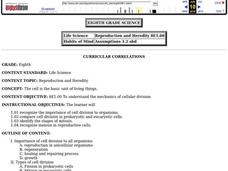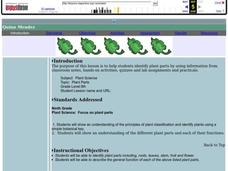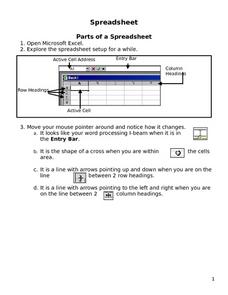Illustrative Mathematics
How Many Cells Are in the Human Body?
Investigating the large numbers of science is the task in a simple but deep activity. Given a one-sentence problem set-up and some basic assumptions, the class sets off on an open-ended investigation that really gives some context to all...
Curated OER
Cell 7 Plant v Animal Cells
Students differentiate between plant and animal cells. They identify the structures central to plant cells. They complete a Venn Diagram listing the differences between animal and plant cells.
Curated OER
Eukaryotic Animal Cell, Candy Cell Model: Science
Pupils review the parts of the eukaryotic animal cell and construct a model using various types of candy.
Curated OER
Living Environment
In this environmental lesson students complete a series of multiple choice and short answer questions on animal populations, cell structure and chromosomes.
Curated OER
Acting Potential
Learners set up a cell membrane with the material provided by their teacher and then arrange beads properly to show how the sodium and potassium ions are arranged. They then make a model representing the axon of a neuron.
Cornell University
Making a Battery
Don't be shocked when your class has a blast making their own batteries! Science scholars examine a dry cell battery, then design and construct a wet cell battery. The activity guides them through the parts of a battery, the variables...
Teach Engineering
Android Acceleration
Prepare to accelerate your Android. Pupils prep for the upcoming activity in this third installment of a four-part series. The lesson progresses nicely by first introducing different types of acceleration to the class. The teacher...
Curated OER
Algae Part One: An Introduction
Students have the opportunity to view two types of algae under 400x magnification with a compound microscope. They make observations and record their observations through drawings and words. In addition, they identify different qualities...
Curated OER
Seeing Cells
Sixth graders study living cells and their functioning units. In this cell lesson students color cell diagrams, answer questions and discuss the differences between plant and animal cells.
University of Minnesota
Connect the Neurons!
Create a neuron frenzy as your pupils play the part of the neurons. An engaging lesson creates a human chain of neurons that pass cotton balls posing as neurotransmitters. Scholars learn about pre- and post-synapses as they complete the...
Curated OER
Science Lesson Plans
Students conduct a variety of exploration activities on various science topics. In this science lesson outline, students design a cell encapsulation to hold a specific type of medicine. They give examples of physical and chemical...
Curated OER
Learning Types of Editorials - and Writing Some
Students recognize and differentiate between the three types of editorials in order to write editorials for the school newspaper. In this editorials instructional activity, students read example persuasive and interpretative editorials....
Curated OER
Dating a Volcanic Eruption
Students discover the various ways in which tree rings can give information. After a brief disucssion of concentric tree rings, they use cross section cut outs of tree rings to identify the time and type of various naturally occuring...
Curated OER
Born of Blood
Eighth graders use a large Punnett Square and infer how genes determine blood types. In this blood type lesson students predict blood types and demonstrate how Punnett Squares are related to genes and chromosomes.
Curated OER
Reproduction and Heredity
Eighth graders study the importance of cell division, compare cell division in prokaryotic and eucaryotic cells, identify the stages of mitosis and recognize meiosis in reproductive cells.
Curated OER
Describing Animals
While a short review of animals and their classifications, this could be useful when discussing this topic in the classroom. There is a list of questions at the end to help review the main ideas. Reptiles, amphibians, and mammals are...
Curated OER
P.L.E.P: Parts of Blood
Middle schoolers examine the different parts of blood. In this human blood lesson plan students work in groups and identify parts of blood and construct a model of human blood.
Curated OER
Plant Parts
Ninth graders identify plant parts by using different classification methods. For this plant lesson students observe and draw different types of leaves then classify them according to species.
Curated OER
Cells and Cancer
Students idenitfy that cancer is a growth of mutated cells and that cancer cells are only one type of cell that causes disease in our body. They also identify that all eukaryotic cells contain a nucleus, cytoskeleton, and a cell...
Give and Let Live
Blood and Transplant: Blood
Why is blood donation so important, anyway? Science and health classes across multiple grades benefit from an in-depth look into the need for and process of blood donation. With an emphasis on presenting the topic in a non-threatening...
Curated OER
Parts of a Spreadsheet
Pupils experiment with the basic functions of a spreadsheet. They practice using headers, footers, functions and fonts. They also organize information.
Deliberating in a Democracy
Cloning
Students explore the issues and challenges of cloning. In this cloning lesson plan, students read about how cloning affects people and the types of cloning, then they prepare a debate either for or against cloning.
Curated OER
Flower Power
Students explore the parts of flowers and how they reproduce. They dissect flowers and observe the reproductive organs. Students observe anthers and ovaries of Tiger Lilies under a microscope. They investigate how insects and other...
Nuffield Foundation
A Closer Look at Blood
Here is a lab that has teenage scientists examining samples of their own blood under a microscope. Learners carefully prepare slides, then make detailed observations and identifying different types of cells using a key.

























